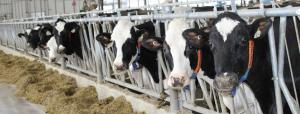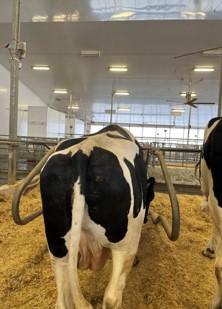
Beefing up dairy cull cows improves welfare and meat quality
Every year, Canadian dairy farmers turn over about one-third of the cows in their milking herd. Cows are culled for various reasons – decreases in milk production or reproductive performance; cases of lameness or disease – and replaced with new animals.
Meat from cull cows generally goes into the lower value lean ground beef market. In Ontario, most dairy cull cows are shipped to a local auction market and then often trucked to the U.S. for processing – a trip that can take several days.
Posted: Thursday, March 21, 2025
Lead photo: The Ontario Dairy Research Centre is an unparalleled research, learning and outreach environment where a broad array of scientific study is possible.
Alliance Impact
86,000 Ontario jobs
Nearly 86,000 jobs are supported by the Ontario dairy industry, according to Dairy Farmers of Ontario
77% graded AAA or prime
17 of 22 fed cows in the study produced meat that graded AAA or prime
2:1 return for producers
Continuing to feed culled dairy cows delivers a 2:1 return for producers, depending on the costs of additional feed space and market prices
Dr. Todd Duffield’s interest in cull cows – or “market” cows as he calls them – was sparked several years ago while working as a provincial veterinary inspector and visiting local auction marts in Ontario. “What I saw made me wonder if we could do something with these cows to improve their welfare and raise their value,” says Duffield, professor and chair of the Department of Population Medicine in the University of Guelph’s Ontario Veterinary College.
Looking for a better way
To learn more, master’s student Allison Moorman studied culled dairy cows at auction barns in Ontario. She found that 40 per cent of the cows had a body condition score of two or less (on a five-point scale) and 72 per cent had an unacceptable gait because of lameness or because they still carried too much milk. Both situations saw these culls sold for lower prices than healthier animals.
The researchers wanted to learn whether farmers might add value and improve the welfare of market cows through greater attention to management after the animals leave the herd but before they leave the farm.
“What if we were able to dry off these cows, feed them for a few weeks, and see if it improved their value by looking at animal welfare and economic returns for producers?” says Duffield. He secured funding for the study from the Ontario Agri-Food Innovation Alliance and from the Dairy Farmers of Ontario and received a letter of support from the Beef Farmers of Ontario.

Dr. Todd Duffield studies metabolic diseases, pain management, and cull dairy cow management.
Over a one-year period, 43 cows culled from the herd at the Ontario Dairy Research Centre were randomized into two groups – either sent directly to processing or fully dried off (no longer lactating) and fed for about 60 days before processing.
Master’s student Nicole Berdusco scored the cows for lameness and hock lesions, udder engorgement and involution (shrinkage as the mammary gland transitions to a non-lactating state), locomotion and body condition score, and then weighed the animals a day before processing. Meat was then assessed for various factors including dressing percentage (a measure of weight that influences price), rib fat, rib eye area and marbling grade.
Extra feeding pays off
The findings were encouraging on all fronts. Keeping culled cows on the farm and feeding them for up to 60 days before going to market improved the animals’ body condition score, welfare measures and meat quality.
Body condition scores for fed cows averaged 3.6, compared to 2.6 for cows that went straight to market. “We saw welfare improvements through increases in body scores, udder involution/lack of engorgement and some improvement in hock scores,” says Duffield.
Meat quality also improved. Fed cow carcasses were larger and fattier with meat that was more tender at every stage of aging. “It was amazing to see the increase in fat marbling in these cows – of the 22 fed cows, five graded prime and 12 graded AAA,” he says.
These improvements could translate into a 2:1 return for producers, after accounting for the costs of housing and feeding the cows, and assuming good market prices.
Duffield plans to further study costs and effects of market price changes.
“There’s a really cool opportunity for a meat product that has value that maybe the industry hasn’t thought about,” says Duffield, “and doing a better job with these cows is important for the long-term sustainability of the dairy industry.”
This research is funded by the Ontario Agri-Food Innovation Alliance, a collaboration between the Government of Ontario, Agricultural Research and Innovation Ontario (ARIO), and the University of Guelph. The Ontario Dairy Research Centre is owned by the Government of Ontario through its agency ARIO and managed by U of G through the Alliance.

Continuing to feed cull cows for up to 60 days before going to market improved body condition scores, welfare and fitness for transportation.

